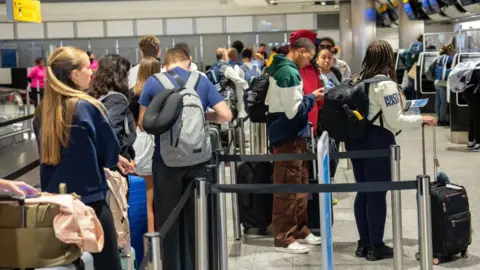On a recent Wednesday, the UK’s air traffic control system was thrust into the spotlight due to a significant radar issue, which resulted in widespread disruptions at airports across the nation and beyond. The problem, although brief—lasting only a mere 20 minutes—led to the cancellation of 150 flights and triggered delays that persisted into the following Thursday, leaving many passengers stranded or anxious about their travel plans.
The core management of the UK’s air traffic is under the purview of NATS (National Air Traffic Services), a company that holds a partial stake from the government. Following the incident, NATS provided minimal details regarding the specifics of the radar malfunction. They stated that a prompt switch to a backup system had mitigated the situation, ensuring safety protocols remained intact. NATS deemed the event as “isolated” and there was no evidence suggesting it resulted from any cyberattacks. Transport Secretary Heidi Alexander reiterated this point, stating that NATS reassured her of the lack of any malign activities involved in the incident.
To gauge the magnitude of the chaos caused by such a fleeting glitch, Graham Lake, a former director general of the Civil Air Navigation Services Organisation (CANSO), described the NATS air traffic network as being akin to a complex web of “motorways in the sky.” He elaborated that losing radar coverage momentarily diminishes the operational capability of the network, transforming it into something akin to “country lanes,” which significantly hampers efficiency and necessitates reduced traffic for safety.
The repercussions of this radar problem raised questions about NATS’s reliability, especially as this was not the first occurrence of a significant outage in recent times. Criticism filtered in from various airlines, with some voicing frustration over NATS’s performance as this incident marked the second major failure of its air traffic system since 2023. In fact, back in August of that year, around 700,000 travelers were affected when a colossal outage led to approximately 500 flight cancellations at major airports. Ryanair, one of the most vocal critics, went as far as calling for the resignation of NATS CEO Martin Rolfe, arguing that lessons were evidently not learned from previous disruptions. EasyJet also expressed its disappointment over the recurrent failings of the air traffic control system, which in many instances left customers incurring lengthy delays or cancellations.
In light of the turmoil, many passengers were advised to check their flight statuses, as some reported their struggles with getting stranded abroad amid the chaos. Nevertheless, Graham Lake also cautioned against scapegoating NATS leadership over these technical failures, emphasizing that they are a part of the operational reality, and highlighting the quick recovery that followed the outage.
The ongoing debate about whether the UK’s airspace is too congested remains significant. Lake noted that British airspace is among the busiest globally, particularly during peak travel seasons. This specific radar issue coincided with one of the busiest moments of the day, amplifying its impact. Consequently, the Heathrow Airlines Operators Committee, a representation body for airlines operating from Heathrow, has lobbied for increased runway capacity in southeastern England as demographic and travel demands continue to rise. Their chief executive, Nigel Wicking, acknowledged the exceptional efforts of NATS operational teams while warning that when the systems are stretched too thin—often referred to as “running hot”—any technical hiccup could lead to substantial repercussions.
The UK government’s stance on expanding airport capacities, particularly for Heathrow, Gatwick, and Luton, signals their awareness of these operational pressures. However, such expansions have met criticism from environmental advocates who highlight concerns regarding increased emissions and air pollution as a result of bolstering air travel capacity. Thus, while the air traffic control system’s reliability is under scrutiny, broader questions about aviation’s environmental footprint and infrastructural adaptability in the UK surface, compounding the challenges ahead for policymakers and stakeholders in the aviation sector.












